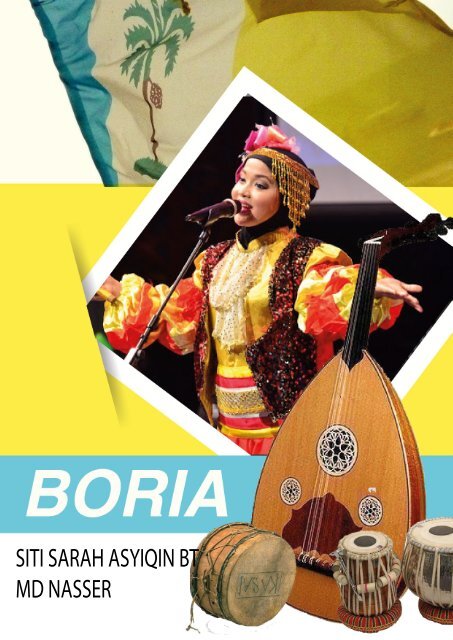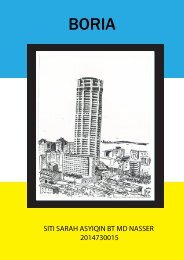Sie wollen auch ein ePaper? Erhöhen Sie die Reichweite Ihrer Titel.
YUMPU macht aus Druck-PDFs automatisch weboptimierte ePaper, die Google liebt.
SITI <strong>SARAH</strong> ASYIQIN BT<br />
MD NASSER
THIS BOOK IS PUBLISHED TO FULFILL THE COURSE REQUIREMENT MUE620 DIGITAL DESKTOP<br />
PUBLISHING UNDER THE SUPERVISION OF DR AHMAD RITHAUDIN MD NOORA<br />
THIS BOOK IS PUBLISHED TO FULFILL THE COURSE REQUIREMENT MUE620 DIGITAL DESKTOP<br />
PUBLISHING UNDER THE SUPERVISION OF DR AHMAD RITHAUDIN MD NOOR
Publisher Information<br />
Series Editor: SITI Sarah<br />
Series Editorial Assistant: Janice Hackenberg<br />
Composition Buyer: Linda Cox<br />
Manufacturing Manager: Megan Cochran<br />
Manufacturing Buyer: Andrew Turso<br />
Editorial-Production Administrator: Karen Mason<br />
Editorial-Production Services: Colophon<br />
Cover Administrator: Kristina Mose-Libon<br />
For related titles and support materials, visit our online catalog at www.ablongman.com.<br />
Copyright 2005 Pearson Education, Inc.<br />
All rights reserved. No part of the material protected by this copyright notice may be reproduced<br />
or utilized in any form or by any means, electronic or mechanical, including photocopying,<br />
recording, or by any information storage and retrieval system, without written permission from<br />
the copyright owner.<br />
To obtain permission(s) to use material from this work, please submit a written request to Allyn<br />
and Bryan, Permissions Department, 75 Jalan Bawal 2, Shah Alam, MA 02116 or fax your request<br />
to 617-848-7340.<br />
Between the time website information is gathered and then published, it is not unusual for<br />
some sites to have closed. Also, the transcription of URLs can result in typographical errors. T<br />
he publisher would appreciate notification where the errors occur so that they may be corrected<br />
in subsequent editions.<br />
Library of Congress Cataloging-in-Publication Data<br />
Oliva, Peter F.<br />
Developing the curriculum / Peter F. Olivia.-6th ed.<br />
p. cm.<br />
Includes bibliography references and index.<br />
ISBN 0-202-41259-9 (alk. paper)<br />
1. Boria history-Pulau Pinang.<br />
LB2806.15.O452004<br />
375’.001-dc22<br />
2004043749<br />
Printed in Malaysia<br />
10 9 8 7 6 5 4 3 2 1 RRD-VA 09 08 07 06 05 04
TABLE OF CONTENT<br />
Content<br />
Chapter 1: History ..................................................................................................... 1<br />
Chapter 2: Costume ................................................................................................. 2<br />
Chapter 3: Musical instrument .............................................................................. 3<br />
Chapter 4: Lyrics and Dance Steps ........................................................................ 4<br />
Chapter 5: Performance .......................................................................................... 5<br />
Bibliography ............................................................................................................. 6
Chapter 1: History<br />
Despite Boria's 150 years of history, the Penang Malay-Jawi<br />
Peranakan parody is slowly losing its grip on<br />
the heritage front. Boria, the traditional parody theatre<br />
that was first originated from the ancient ta'ziyeh culture<br />
of Persia is known for their medley of traditional music<br />
and chorus singing. Today, boria remains characteristically<br />
and typically a choric performance with the tukang<br />
karang in charge and reciting the more significant poetic<br />
passages whose lyrics he composes. Minimal dance<br />
movements or gestures are included and large modern<br />
bands accompany performances.<br />
In the early history of the Boria, only men acted all<br />
the parts. But since the 1950s female Boria groups began<br />
to emerge. Today there are mixed gender troupes, and in<br />
these troupes the men do the acting and the women do<br />
Despite Boria's 150 years of history, the Penang Malay-Jawi<br />
Peranakan parody is slowly losing its grip on<br />
the heritage front. Boria, the traditional parody theatre<br />
that was first originated from the ancient ta'ziyeh culture
Chapter 2: Costume<br />
The costumes used in the Boria performed in the villages<br />
is usually the normal street wear of the performers,<br />
or a costume appropriate for the story being performed.<br />
However, in a staged performance in a hall or on television,<br />
the costumes consist of colorful uniforms worn by<br />
all the performers which are robes, modelled upon original<br />
sack-cloth garments characteristics or early boria and<br />
hats, often funny in shape
Chapter 3: Musical Instrument<br />
Boria musical instruments have changed over time. However,<br />
Boria is accompanied by a band that usually sits at the<br />
back area of the stage. In former times, the ensemble included<br />
violin, gambus plucked lute, marwas hand drums, Indian<br />
tabla, accordion, gendang, cymbals, and harmonica.<br />
The main melodic instruments has consistently violin,<br />
include Malay, or Indian drums which is marwas and tabla in<br />
the Boria performance.
Chapter 4: Lyrics and Dance Steps<br />
The tukang karang lyrics are sung to tunes borrowed from Western,<br />
Malay and Hindustani popular music. In the absence of scripts,<br />
the tukang karang had to improvise his lyrics ex tempore. Recent<br />
years have seen the increasing use of fixed scripts, sometimes following<br />
censorships by government licensing bodies. The first copies of<br />
each song in the Boria dance must introduce each group and duplicate,<br />
and this will be the chorus to this song in a Boria dance. Example<br />
as below:<br />
Boria Anak Tanjung<br />
Salam sejahtera kami ucapkan,<br />
Kepada hadirin yang kami muliakan,<br />
Kegebatan boria kita dengarlan,<br />
Boria Anak Tanjung mohon dendangkan.<br />
At the end of the event, Boria groups often ask for forgiveness if<br />
there is one during the dance event at that time. If we heard the<br />
sound function or words like in the example, it is a sign Boria dance<br />
event at that time was running out and completed. Example:<br />
Tamatlah sudah madah karangan,<br />
Kalau tersilap dimarah jangan,<br />
Budaya boria dibuat sebagai pegangan,<br />
Boria Anak Tanjung melambaikan tangan.
An excerpt of Sambutan Dewi Bunga, by the tukang karang, in a boria performance.<br />
The dance steps of chorus members are based upon popular Western dances such as<br />
cha-cha or tango. Preferred local dance styles include zapin, inang, or joget. Dances from other<br />
cultures, such as Indian or Middle Eastern that were once fashionable are today<br />
rarely encountered.
Chapter 5: Performance<br />
A performance is divided into two segments: a comic<br />
story or comedy sketch, and a song and dance section.<br />
The two segments feature the same story or theme.<br />
The comedy sketch is usually acted by 10 to 14 actors.<br />
The theme of the story is presented in a comic sketch<br />
with slapstick comedy and improvised dialogue. A small band plays instrumental music<br />
to<br />
accompany the story and to produce sound effects whenever needed.<br />
The second part in the performance consists of songs and dances that occur a number<br />
of times.<br />
This part is presented by a solo singer and a chorus consisting of about 30 to 40 people<br />
(smaller groups use 10-12 people). The members of the chorus also dance and they are<br />
referred to<br />
as the kelasi or sailors, while the solo or lead singer is known as the tukang karang.<br />
Boria combined entertainment with social criticism. These functions continue to be<br />
important in contemporary performances. The bad effects of gambling or drinking and<br />
even of multiple marriage, for instance, are often highlighted. Boria, still popular in<br />
Penang, remains unique to that state.
Bibliography<br />
Boria : A passage through time. MyPenang website. Retrieved from http://mypenang.<br />
gov.my/index.aspx?page=page-1091-boria_a_passage_through_time- 1<br />
130;1091;1073;991;794;.pgt on 26 August 2014.<br />
Hamilton, A. W. 1920. The boria. Journal of the Straits Branch Royal Asiatic Society<br />
82: 139–144.<br />
Rahmah Bujang (1987). Boria: a form of Malay theatre (Local history and<br />
memoirs). Institute of Southeast Asian Studies. pp. xii,1 & 2.<br />
Terry Miller & Sean Williams (2008). The Garland Handbook of Southeast Asian<br />
Music. Routledge. p. 236 & 237
Sarah Nasser is an Editorial Campaigns<br />
Assistant at Mashable's New<br />
York City headquarters, where she<br />
researches and writes custom content.<br />
She graduated from the Faculty<br />
of Music, with bachelos degrees<br />
in Music Education in 2018. After<br />
graduation she lived in Madrid for<br />
one year and traveled extensively<br />
before moving to New York. She is currently working on a<br />
Master's of Music Education at New York University. Before<br />
interning at Mashable she was at Hearts Digital Media Working<br />
in digital media marketing.<br />
Despite Boria's 150 years of history, the Penang Malay-Jawi Peranakan<br />
parody is slowly losing its grip on the heritage front. Boria, the traditional<br />
parody theatre that was first originated from the ancient ta'ziyeh culture of<br />
Persia is known for their medley of traditional music and chorus singing.<br />
Today, boria remains characteristically and typically a choric performance<br />
with the tukang karang in charge and reciting the more significant poetic<br />
passages whose lyrics he composes. Minimal dance movements or<br />
gestures are included and large modern bands accompany performances.






